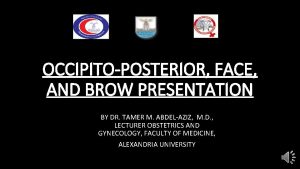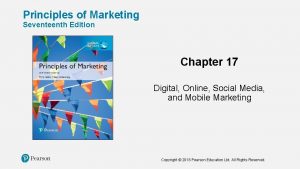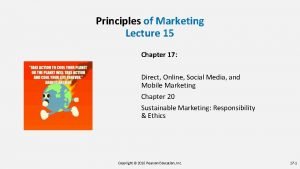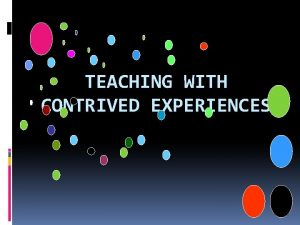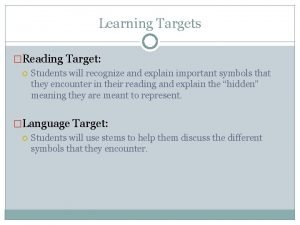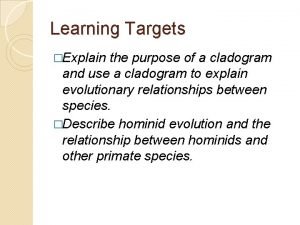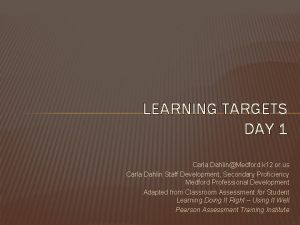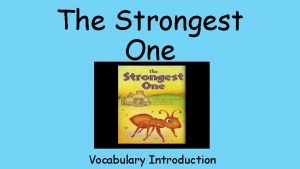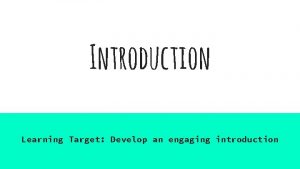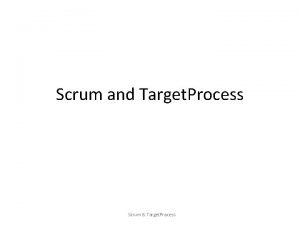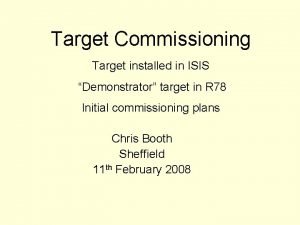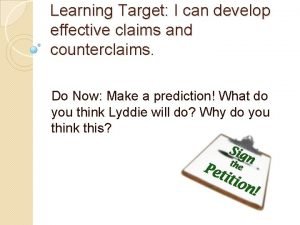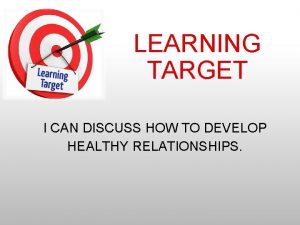Introduction Learning Target Develop an engaging introduction Introduction












- Slides: 12

Introduction Learning Target: Develop an engaging introduction

Introduction: The goal: 1 -Hook the audience 2 -Establish the problem/issue 3 -Connect to audience 4 -Present Thesis

Step 1: have a “hook” (2 -4 sentences) Find a quote, startling statistic, question, and anecdote that PULLS your audience in and sets the tone for your presentation. We will spend time developing all 4 types for our intro. Later we will determine which type of hook you should use.

Write your hook You will have time to look through your sources. You should not use the hook from your Capstone Proposal. 1 -Cite any sources: “According to…” 2 -Focus on pathos (emotion) 3 -Ask yourself: “Will this draw the audience in? ”

“Hook” continued (~5 min) Start by identifying an intriguing quote. HERE IS AN EXAMPLE: Standards Based Grading “Grades are so imprecise they are almost meaningless” (Marzano 1). Quote:

“Hook” continued (~5 min) Find some startling statistics. EXAMPLE: Standards Based Grading Education Weekly reports that 75% of high school students rank getting extra credit as their #1 strategy to improve their grades.

“Hook” continued (~3 min) Put together a string of at least 3 provocative Qs. HERE IS AN EXAMPLE: Standards Based Grading Question: “What if every student could tell you their strengths and weaknesses? What if every student could improve their weaknesses over the course of a semester? What if students had the opportunity to enhance their strengths? Would you say this is an education system to invest in?

“Hook” continued (~5 min) Share a story - a personal story, a story from one of you sources, a story from one of the videos you posted to your blog. Tell your/their story. Use the name of the person. HERE IS AN EXAMPLE: Standards Based Grading Anecdote: “Follow the academic journey of Jenny. For many of her years in school she was a C student. For her that meant she wasn’t very smart, and she didn’t know what she needed to do to improve her grades. In fact, for her grades weren’t very important anyway. For many of her classmates, getting good grades is point grubbing and finding ways to beat the system.

Step 2: Establish your problem/issue (3 -5 sentences) Describe the problem/issue/career you are presenting in your own words. Consider the 5 W’s Who does this problem/issue/career affect? What is the problem/issue/career? What is the impact of the issue? What would happen if we don’t deal with the problem/issue/career? When does the problem/issue occur? Where is it taking place?

Step 3: Connect to audience (2 -4 sentences) Tell your audience why this problem/issue should be important to them and how it benefits them. Give a preview of your WHY and the WHO. Consider answering these Qs: How does this problem/issue/career affect your TA? What are the consequences of this problem/issue/career if it is not addressed properly? Why should people care? Who will benefit from what you are going to share in your

Step 4: Present your thesis (1 sentence)

Step 1: Name your target audience Consider the following questions: Who is the ideal reader for your blog? What group of people do they represent? Who was the target of your social awareness campaign? What are their issues/problems, and concerns? How is this group of people touched/related to your issue/problem/career? Now name the group of people who will make up your Target Audience (TA).
 Occipito posterior position
Occipito posterior position Engaging dynamics
Engaging dynamics Marketing involve engaging directly with carefully targeted
Marketing involve engaging directly with carefully targeted Marketing involve engaging directly with carefully targeted
Marketing involve engaging directly with carefully targeted Primary target market and secondary target market
Primary target market and secondary target market Examples of contrived activities
Examples of contrived activities Cuadro comparativo e-learning y b-learning
Cuadro comparativo e-learning y b-learning Slo goal statement examples
Slo goal statement examples What does janie overalls symbolize
What does janie overalls symbolize What is the purpose of a cladogram
What is the purpose of a cladogram Sample learning targets for reasoning
Sample learning targets for reasoning Learning situation analysis
Learning situation analysis Learning target
Learning target
